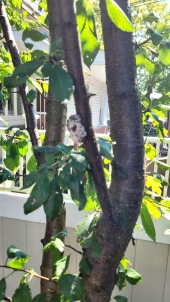




"Limitation is the mother of good management", Michael Evanari
Location: Southwestern Oregon (Jackson County), Zone 7








"Limitation is the mother of good management", Michael Evanari
Location: Southwestern Oregon (Jackson County), Zone 7





"Limitation is the mother of good management", Michael Evanari
Location: Southwestern Oregon (Jackson County), Zone 7












"Limitation is the mother of good management", Michael Evanari
Location: Southwestern Oregon (Jackson County), Zone 7




 ). I would be interested in seeing your arboretum sometime. [edit] I see you're in Jackson County, so the climate's a bit different than mine, still like to see your arboretum. [/edit]
). I would be interested in seeing your arboretum sometime. [edit] I see you're in Jackson County, so the climate's a bit different than mine, still like to see your arboretum. [/edit]Intermountain (Cascades and Coast range) oak savannah, 550 - 600 ft elevation. USDA zone 7a. Arid summers, soggy winters




"Limitation is the mother of good management", Michael Evanari
Location: Southwestern Oregon (Jackson County), Zone 7




Intermountain (Cascades and Coast range) oak savannah, 550 - 600 ft elevation. USDA zone 7a. Arid summers, soggy winters










"Limitation is the mother of good management", Michael Evanari
Location: Southwestern Oregon (Jackson County), Zone 7






"Limitation is the mother of good management", Michael Evanari
Location: Southwestern Oregon (Jackson County), Zone 7





Intermountain (Cascades and Coast range) oak savannah, 550 - 600 ft elevation. USDA zone 7a. Arid summers, soggy winters




"Limitation is the mother of good management", Michael Evanari
Location: Southwestern Oregon (Jackson County), Zone 7






"Limitation is the mother of good management", Michael Evanari
Location: Southwestern Oregon (Jackson County), Zone 7




"Limitation is the mother of good management", Michael Evanari
Location: Southwestern Oregon (Jackson County), Zone 7








"Limitation is the mother of good management", Michael Evanari
Location: Southwestern Oregon (Jackson County), Zone 7




Kay Bee wrote:Hi Dave,
I haven't seen any bats using it for drinking or hunting as of yet. Interesting thought, though. I'll have to watch more closely in the evenings...
There are a lot of dragonflies that hunt around 30 feet up in the air as the evening insects come out. I suspect the hunting for the bats must be pretty good up there.
I'd like to establish some bat houses on the property. We received on as a gift at our old place, but it never was occupied over the years. Need to do some more research on positioning, and such.





"Limitation is the mother of good management", Michael Evanari
Location: Southwestern Oregon (Jackson County), Zone 7




"Limitation is the mother of good management", Michael Evanari
Location: Southwestern Oregon (Jackson County), Zone 7




"Limitation is the mother of good management", Michael Evanari
Location: Southwestern Oregon (Jackson County), Zone 7




"Limitation is the mother of good management", Michael Evanari
Location: Southwestern Oregon (Jackson County), Zone 7




"Limitation is the mother of good management", Michael Evanari
Location: Southwestern Oregon (Jackson County), Zone 7




"Limitation is the mother of good management", Michael Evanari
Location: Southwestern Oregon (Jackson County), Zone 7




"Limitation is the mother of good management", Michael Evanari
Location: Southwestern Oregon (Jackson County), Zone 7




"Limitation is the mother of good management", Michael Evanari
Location: Southwestern Oregon (Jackson County), Zone 7






"Limitation is the mother of good management", Michael Evanari
Location: Southwestern Oregon (Jackson County), Zone 7

|
They kept fire breathing monkeys as pets! This tiny ad told me so!
Learn Permaculture through a little hard work
https://wheaton-labs.com/bootcamp
|




